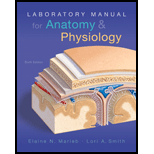
Which is a function of the skeletal system? (a) support, (b) hematopoietic site, (c) storage, (d) providing levers for muscle activity, (e) all of these.
To determine:
The function of skeletal system is
Support
Hematopoietic site
Storage
Providing levers for muscle activity
All of these
Answer to Problem 1MC
Solution:
(e) All of these: The function of the skeletal system is to provide lever to the muscles. Bones are the hematopoietic sites. They store nutrients and support the body.
Explanation of Solution
Explanation/ Justification for the correct answer:
The skeletal system in humans consists of 206 bones and a network of tendons and ligaments. The main functions of this system include the movement, support, protection, formation of various blood cells as well as the storage of calcium and other nutrients in the matrix, and endocrine regulation by releasing the hormone known as osteocalcin. Thus option (e) is a correct option.
Explanation for the incorrect answer:
Option (a) is given as support is the function of skeletal system. Skeletal system performs a number of functions like support, protection, formation of various blood cells, storage of nutrients and lever to the muscles. Here, only support is mentioned as a function of skeletal system, thus this option is considered as incorrect option.
Option (b) is given as skeletal system is a hematopoietic site. Skeletal system performs a number of functions like support, protection, formation of blood cells (hematopoietic site), storage of nutrients and lever to the muscles. Here, only hematopoietic site is mentioned as a function of skeletal system, thus this is considered as incorrect option.
Option (c) is given as storage is a function of skeletal system. Skeletal system performs a number of functions like support, protection, formation of various blood cells, storage of nutrients and lever to the muscles. Here, only storage is mentioned as a function of skeletal system, thus this is considered as incorrect option.
Option (d) is given as providing levers for muscle activity is a function of skeletal system. Skeletal system performs a number of functions like support, protection, formation of various blood cells, storage of nutrients and lever to the muscles. Here, only providing levers for muscle activity is mentioned, thus this is an incorrect option.
Thus it is concluded that skeletal system perform a number of functions such as support, protection, formation of various blood cells, storage of calcium and other nutrients and also provide lever to the muscles.
Want to see more full solutions like this?
Chapter 6 Solutions
Laboratory Manual for Anatomy & Physiology (6th Edition) (Anatomy and Physiology)
Additional Science Textbook Solutions
Microbiology: An Introduction
Applications and Investigations in Earth Science (9th Edition)
Chemistry: An Introduction to General, Organic, and Biological Chemistry (13th Edition)
Organic Chemistry (8th Edition)
Human Physiology: An Integrated Approach (8th Edition)
Campbell Biology: Concepts & Connections (9th Edition)
- Not part of a graded assignment, from a past midtermarrow_forwardNoggin mutation: The mouse, one of the phenotypic consequences of Noggin mutationis mispatterning of the spinal cord, in the posterior region of the mouse embryo, suchthat in the hindlimb region the more ventral fates are lost, and the dorsal Pax3 domain isexpanded. (this experiment is not in the lectures).a. Hypothesis for why: What would be your hypothesis for why the ventral fatesare lost and dorsal fates expanded? Include in your answer the words notochord,BMP, SHH and either (or both of) surface ectoderm or lateral plate mesodermarrow_forwardNot part of a graded assignment, from a past midtermarrow_forward
- Explain in a flowcharts organazing the words down below: genetics Chromosomes Inheritance DNA & Genes Mutations Proteinsarrow_forwardplease helparrow_forwardWhat does the heavy dark line along collecting duct tell us about water reabsorption in this individual at this time? What does the heavy dark line along collecting duct tell us about ADH secretion in this individual at this time?arrow_forward
 Human Biology (MindTap Course List)BiologyISBN:9781305112100Author:Cecie Starr, Beverly McMillanPublisher:Cengage Learning
Human Biology (MindTap Course List)BiologyISBN:9781305112100Author:Cecie Starr, Beverly McMillanPublisher:Cengage Learning Human Physiology: From Cells to Systems (MindTap ...BiologyISBN:9781285866932Author:Lauralee SherwoodPublisher:Cengage Learning
Human Physiology: From Cells to Systems (MindTap ...BiologyISBN:9781285866932Author:Lauralee SherwoodPublisher:Cengage Learning Principles Of Radiographic Imaging: An Art And A ...Health & NutritionISBN:9781337711067Author:Richard R. Carlton, Arlene M. Adler, Vesna BalacPublisher:Cengage Learning
Principles Of Radiographic Imaging: An Art And A ...Health & NutritionISBN:9781337711067Author:Richard R. Carlton, Arlene M. Adler, Vesna BalacPublisher:Cengage Learning Anatomy & PhysiologyBiologyISBN:9781938168130Author:Kelly A. Young, James A. Wise, Peter DeSaix, Dean H. Kruse, Brandon Poe, Eddie Johnson, Jody E. Johnson, Oksana Korol, J. Gordon Betts, Mark WomblePublisher:OpenStax College
Anatomy & PhysiologyBiologyISBN:9781938168130Author:Kelly A. Young, James A. Wise, Peter DeSaix, Dean H. Kruse, Brandon Poe, Eddie Johnson, Jody E. Johnson, Oksana Korol, J. Gordon Betts, Mark WomblePublisher:OpenStax College Medical Terminology for Health Professions, Spira...Health & NutritionISBN:9781305634350Author:Ann Ehrlich, Carol L. Schroeder, Laura Ehrlich, Katrina A. SchroederPublisher:Cengage Learning
Medical Terminology for Health Professions, Spira...Health & NutritionISBN:9781305634350Author:Ann Ehrlich, Carol L. Schroeder, Laura Ehrlich, Katrina A. SchroederPublisher:Cengage Learning





